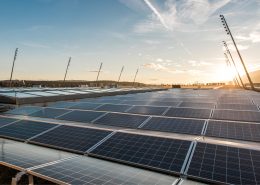Dear SFOE: Why are solar plants black?
The Swiss Federal Office of Energy (SFOE) answers hundreds of enquiries from citizens every year. On energeiaplus.com we take up some of them under the keyword "Dear SFOE...". Mrs M. wanted to know why solar panels are black and not white or grey.
Dear Mrs. M., that's a good question. To answer it, you need a little physics lesson:
Light propagates in the form of waves. Depending on the wavelength we perceive different colours. Blue light, for example, has a shorter wavelength than red light. And white consists of many different colours which together appear white. You can see this when white rays of sunlight fall on a drop of water: The light is refracted, broken down into its colored components and there is a rainbow.
When the light hits an object, certain wavelengths are either swallowed (absorbed) or reflected. The reflected wave hits our eye and we perceive it as the color of the object. Example: In a red ball, all other wavelengths except red are absorbed and only red is reflected.
What we perceive as black is actually the absence of color: an object absorbs light completely - and thus also heat - and does not reflect anything back. This is exactly what happens with black photovoltaic systems. This is the intention, because all the sun's rays should be absorbed and converted into electricity. A grey or white PV system would reflect a comparatively large amount of sunlight, so not all the light that hits the system could be used to generate electricity.
Nevertheless there are them, the non-black solar cells. The CSEM Research and Technology Institute in Neuchâtel, for example, has equipped the façade of an apartment building with white solar modules. They are coloured with a special layer that makes the modules appear white. Other colours or patterns are also possible, and depending on the colouring and product, losses range from a few to a maximum of 30%. The company Solaxess, a start-up company of the CSEM, offers nanotechnology films for manufacturers of photovoltaic solar modules, which are available in different colours. And in Ecuvillens, Fribourg, a terracotta-coloured photovoltaic system was installed on a listed building, as you can read in the energy report of 4 October 2017. So it is quite possible that in the future we will see more and more white or colored solar roofs and facades or colored billboards that produce their own electricity.
Alicia Salas, university trainee media and politics, SFOE

 ShutterstockMoney talks
ShutterstockMoney talks  Schweizer SolarpreisWir brauchen mehr grosse Solaranlagen!
Schweizer SolarpreisWir brauchen mehr grosse Solaranlagen!  ARESachplan geologische Tiefenlager im Vergleich
ARESachplan geologische Tiefenlager im Vergleich  Geoinformation - swisstopo, BFENeue Geoinformations-Karte zeigt, wo die solare Einstrahlung am besten ist
Geoinformation - swisstopo, BFENeue Geoinformations-Karte zeigt, wo die solare Einstrahlung am besten ist 
 Shutterstock
Shutterstock Shutterstock
Shutterstock
Warum muss der Stromverbrauch und Sonne oder Wind usw. immer genau gleich Stark sein?
Grüezi Frau Alicia Salas,
Sie haben oben geschrieben wegen den schwarzen Solarzellen. Ich glaube die sind leider kontraproduktiv.
Sehen Sie diese Zellen werden bei Sonne doch zwischen 50 und 70°C heiss!. Auch im Winter bei Windstille.
Das heisst, wenn wir in der ganzen Schweiz mit solchen Zellen alle Dächer bedecken, dann tragen wir ohne co2 zur Erderwärmung bei.
Der Wirkungsgrad ist sicher schlecht. Ausser man könnte sie als Warmwasser Kollektor verwenden.
Wieso kann man diese Zellen nicht, wie das Silicium ist silbergrau matt, lassen, so wie das Haus oben?
Oder man macht sie Ziegelrot wie Dachziegel. Dann könnte man sie sogar auf alten Häusern einsetzen.
Freundliche Grüsse
Urs Bütler